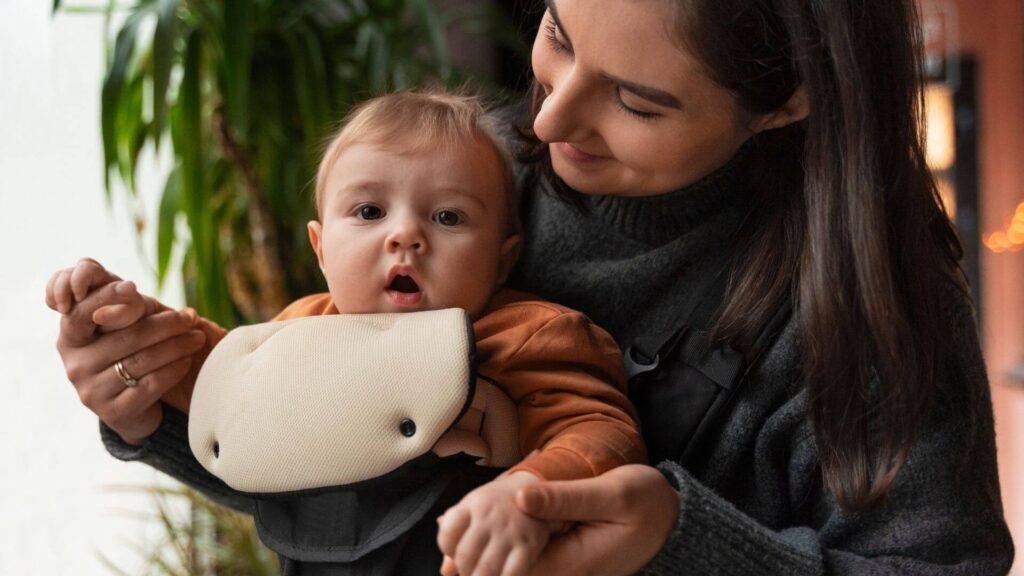
Are you wondering when can your baby to face forward in their carrier? Join me as we delve into this exciting milestone, unlocking new possibilities for bonding and discovery.
As your baby grows and becomes more curious about the world around them, the prospect of facing forward in a carrier opens up a whole new realm of exploration.
Discover the signs that indicate your little adventurer is ready to take on the world facing forward and learn how this transition can enhance your outdoor adventures together.
Imagine the joy on your baby’s face as they gaze out into the world, taking in the sights and sounds from the comfort and security of their carrier. Let’s make every moment of exploration and discovery count!
What to Consider Before Facing Forward?
Age and Developmental Considerations
A baby’s spine, neck, and hip structures are not fully developed, usually before the age of 4 to 6 months. The ‘C-curve’ in their spines, which is more pronounced in newborns and offers natural protection, has not yet straightened, and their necks are not strong enough to bear the weight of their heads in a forward-facing position.
Pediatric Recommendations for Baby Positioning
Leading bodies in pediatric care, such as the American Academy of Pediatrics (AAP), stress the importance of keeping babies in a position with their backs rounded (fetal position) with the thighs supported, particularly in the first few months of life. This helps prevent hip dysplasia, a condition where the hip joint doesn’t properly develop.
Physical and Cognitive Readiness Indicators
As your baby starts to show signs of stronger neck control, they could become ready for brief stints in an outward-facing position. Look for your child to enjoy a wide field of vision, actively looking around and engaging with their environment, indicating the cognitive and physical readiness for a new way of carrying.
Benefits of Facing Forward
1. Interaction and Stimulation
When a baby becomes forward-facing, their world transforms from a limited parental view to an exciting panorama—trees, passing strangers, and the family dog all come into focus, stimulating their senses and encouraging cognitive development.
2. Comfort and Curiosity
Facing forward can also offer relief from boredom, for babies can become quickly over it and need to be shuffled to a different position. Moreover, curious infants often strain to see more of the environment, which can be unbalancing when carried facing in. Facing forward permits a more natural line of sight.
3. Parent-Child Bonding
Despite the benefits this position offers in terms of exploration and engagement, it is important to note that the act of carrying a baby is, in itself, a profound bonding experience, whether they face in or out. In fact, many parents report a special sense of closeness when their child is in a more traditional ‘facing in’ position in the carrier, with the added advantage of increased support to the child’s head and neck.
Potential Risks and Concerns
Although it is fun for both parents and the child when the child can have fun and be distracted with other things while the parents get the freedom to do chores or relax, there are still some potential risks that you should look out for:
Impact on Baby’s Spine and Hip Development
The external, forward position places added strain on a baby’s underdeveloped spine. Over time, this can lead to poor posture and potential back problems. Furthermore, it’s essential to consider your baby’s hip health, ensuring their legs are not dangling straight down but are in a spread-squat position to avoid potential hip dysplasia issues.
Over-stimulation and Fatigue
While babies are naturally curious, they can become overstimulated by the vast array of new sensory inputs. Extended periods in an outward-facing position can lead to fatigue as they struggle to process the onslaught of new information.
Lack of Head and Neck Support
When a baby faces inward, the carrier naturally supports its head and neck. In contrast, outward-facing carriers may not offer the same level of support, heightening the risk of overextension and leading to potential injury or discomfort.
Alternative Carrying Positions
Back Carrying
When your child has reached the milestone of sitting on their own (typically around six months), back carrying is an excellent way to balance their need for support with the fascinating perspective the world offers.
Hip Carrying
This evolved form of side carrying works well for quick interactions or when you need a change from the traditional front-facing in position. Make sure to use a carrier designed specifically for hip carrying to ensure comfort and safety for both you and your infant.
Facing Inward
The traditional carrying position remains an excellent choice for its safety and the enduring bond it fosters between parent and child. It’s particularly recommended for newborns and young infants, who benefit from the security of body-to-body contact and can witness facial expressions while feeling the parent’s heartbeat and warmth.
So, When Can Baby Face Forward in Carrier?
There is no one-size-fits-all answer to the question of when babies can face forward in a carrier. It is advisable for parents to consult with their pediatricians to ensure they are making informed choices that consider their baby’s health and well-being. Remember, every child is different, and it’s essential to pay attention to your baby’s cues and let them guide you in finding the best ways to carry them.
By understanding the recommended guidelines, paying attention to their development indicators, and considering all potential risks and alternative positions, parents can make an informed decision on when their baby is ready for facing forward in a carrier. Happy babywearing!
Psst! Are you a new parent starting to step into the world of parenthood, or a seasoned parent trying to change out the old baby carriers to new ones? Check out here for the best baby carriers to compare and choose from.
FAQs
When can my baby safely face forward in a baby carrier?
It’s generally recommended to wait until your baby has strong neck and head control, typically around 4 to 6 months of age (or older), before allowing them to face forward in a carrier. Always consult with your pediatrician for personalized guidance.
What signs should I look for to know if my baby is ready to face forward?
Look for signs of neck strength and control, such as the ability to hold their head steady and upright for extended periods. Additionally, observe their interest in their surroundings and their ability to support themselves in a seated position.
Are there any risks associated with facing my baby forward in a carrier too early?
Yes, facing a baby forward prematurely can strain their neck and back muscles, potentially causing discomfort or even injury. It’s crucial to wait until your baby is developmentally ready before making this transition.
How can I ensure my baby’s comfort and safety when facing forward in a carrier?
Make sure the carrier provides adequate support for your baby’s hips and spine in the forward-facing position. Keep an eye on their cues and adjust the carrier as needed to ensure they’re comfortable and not overstimulated by their surroundings.




